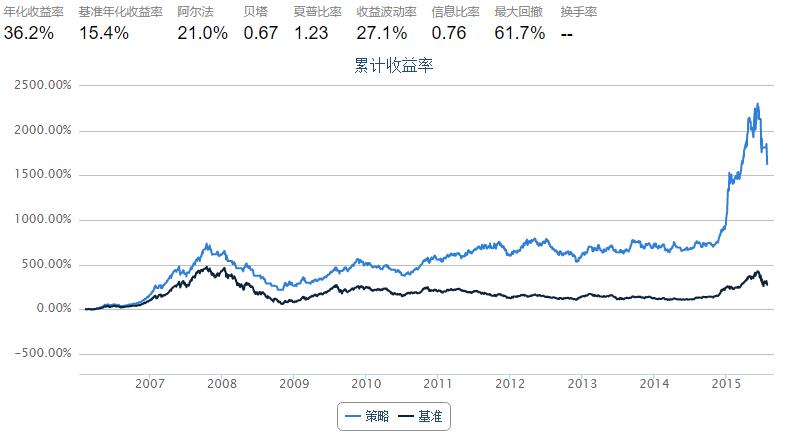策略探讨(更新):价量结合+动量反转
前篇简介:
- 在前一篇文章中,对策略理念和流程大致走了一遍
- 对quartz中的参数优化过程以及简单策略分析也做了简单示例
仍存在的问题:
- 前一篇中代码细节问题修正
- 停牌数据问题以及其他小细节
- 收益波动性太大、熊市不抗跌
下面就结合实际情况,对上述问题进行逐个分析
# step1:前篇代码细节修正
# 如前篇描述,(-inf,negative2,negative1,postive1,positive2,inf)将整个数轴分成了5个区间段,从左到右,每个区间段分别代表(long,short,nothing,long,short)操作
# 而在前篇的代码中忽略掉了小细节,将修正后的部分代码简单展示如下:
signal = closeprice[stk][-1]/wp - 1
if stk in account.valid_secpos and (signal > positive2 or negative2 < signal < negative1):
selllist.append(stk)
elif stk not in account.valid_secpos and (positive2 > signal > positive1 or signal < negative2):
buylist.append(stk)
step2:数据质量问题再分析
- 首先分析一下数据细节问题,策略中唯一要计算的指标是加权平均价,要用到过去一段时间的收盘价和成交量,倘若过去时间里有停牌呢?
- 之前的简单处理是,若全部停牌会导致wp计算出来为nan,然后把它舍弃掉,但是倘若过去所用的时间段内刚巧只有一天是没停牌的呢?
- 查看DataAPI原始数据发现,停牌时,收盘价是filldown处理的,当日成交量是为0的
- 所以要保证所计算出来的加权平均价wp的相对合理性,必须要保证所计算的过去数据的有效性,这里的处理是:若停牌天数超过window/2时,则不进行任何操作
# step2对应的代码修改部分(非运行代码,只做展示说明,下同) .... for stk in account.universe: if sum(volumn[stk] > 0) <= window/2: continue ....
step3:收益波动性太大
- 如前篇描述,(-inf,negative2,negative1,postive1,positive2,inf)将整个数轴分成了5个区间段,从左到右,每个区间段分别代表(long,short,nothing,long,short)操作
- 结合实际考虑,股市里目前没有实际的short操作,回测的策略只是LongOnly,对应的short信号只是卖掉持有的股票,所以要结合实际对信号做一些更改
- 整体思路是:买入的信号不变,short的信号是卖掉手中股票的信号,而并不是开空仓的信号,因为即使预测对了下跌也是赚不到钱的
- 改进点是: negative1变为0
# step3:对应要修改的代码
negative1 = 0
step4:熊市不抗跌
- 遇到熊市时,可以考虑设置止损线,虽然不能做空,但是降低仓位可以逃过一部分损失
- 止损条件有两点考虑:一是现有组合市值短期亏损比较大就止损;二是大盘过去一段时间里下跌很多,要止损(近似于宏观择时操作)
- 止损条件1:当沪深300在过去3周累计下跌超过10%时,下一期不持仓
- 止损条件2:当组合净值在过去3周累计缩水超过10%或者在过去一周累计缩水5%,下一期不持仓
from datetime import datetime, timedelta
import numpy as np
start = '2006-01-01' # 回测起始时间
# end = '2015-01-01'
today = datetime.today()
delta = timedelta(days = -1)
end = (today+delta).strftime('%Y-%m-%d')
benchmark = 'HS300' # 策略参考标准
universe = set_universe('SH50') # 证券池,回测支持股票和基金
capital_base = 10000000 # 起始资金
refresh_rate = 5 # 调仓频率,即每 refresh_rate 个交易日执行一次 handle_data() 函数
window = 20 # 取过去行情数据
positive2 = 0.1 # 信号突破比例阈值
negative2 = -0.1
positive1 = 0.01
negative1 = 0
stoploss_percent = 0
def initialize(account): # 初始化虚拟账户状态
account.portfoliovalue = [] #记录组合市值
def handle_data(account): # 每个交易日的买入卖出指令
# 止损判断
hs300 = account.get_symbol_history('benchmark',window)['closeIndex']
account.portfoliovalue.append(account.referencePortfolioValue)
if hs300[-1]/hs300[-16] - 1 < -0.1: # 止损条件1
for stk in account.valid_secpos:
order_to(stk,0)
return
if len(account.portfoliovalue) < 4: # 止损条件2
pass
elif account.portfoliovalue[-1]/account.portfoliovalue[-4] - 1 <= -0.1 or account.portfoliovalue[-1]/account.portfoliovalue[-2] - 1 <= -0.05:
for stk in account.valid_secpos:
order_to(stk,0)
return
# 取行情
closeprice = account.get_attribute_history('closePrice',window)
volumn = account.get_attribute_history('turnoverVol',window)
reference_p = account.referencePrice # 参考价
cash = account.cash # 剩余现金
# 计算买入卖出
buylist = []
selllist = []
for stk in account.universe:
if sum(volumn[stk] > 0) <= window/2: continue
wp = np.dot(closeprice[stk], volumn[stk]/sum(volumn[stk])) # 成交量加权价
signal = closeprice[stk][-1]/wp - 1
if stk in account.valid_secpos and (signal > positive2 or negative2 < signal < negative1):
selllist.append(stk)
elif positive2 > signal > positive1 or signal < negative2:
buylist.append(stk)
# 卖出下单
for stk in selllist:
order_to(stk,0)
cash = cash + account.valid_secpos[stk] * reference_p[stk]
# 买单分解为需要新买的+已有持仓的
holds = [stk for stk in account.valid_secpos if stk not in selllist]
new_buy = [stk for stk in buylist if stk not in holds]
# 买入操作
for stk in new_buy:
order(stk,int(cash/len(new_buy)/reference_p[stk]))

- 可以看到,加入简单的止损后,策略效果有明显改善,尤其是在07年~08年熊市阶段,躲过了很多下跌
- 同时也看到,在最近的大跌行情中表现一般,主要原因是周度策略,一周换一次仓,周中的大跌是难以避免的,一个好的做法是考虑周中止损,这一点可以自行尝试
- 除了直接的止损外,还可以考虑加入择时,比如预测涨就全仓,预测跌就1/3仓位等,上面展示的只是最简单的想法,更细致的东西还有待去研究